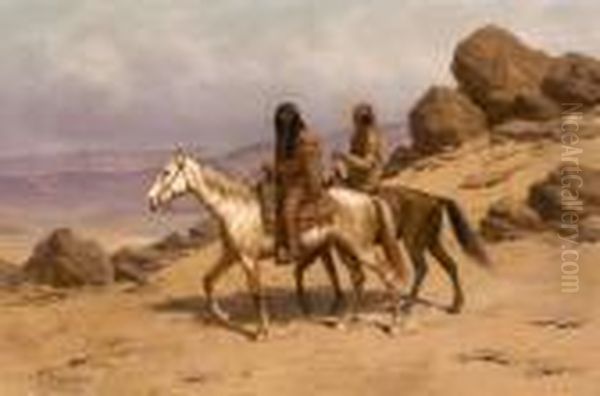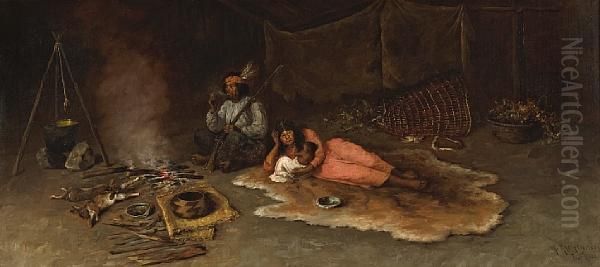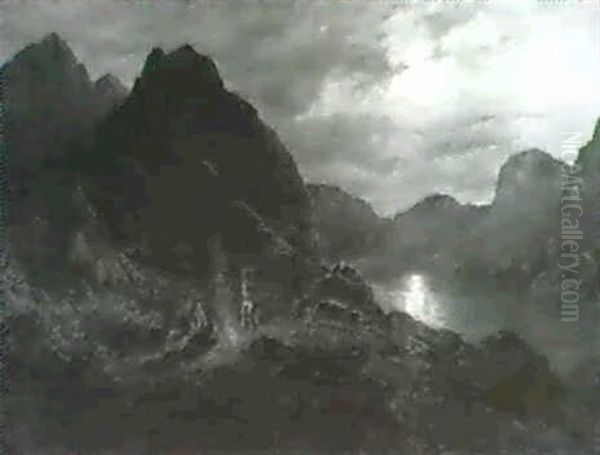Henry Raschen stands as a significant, if sometimes overlooked, figure in the annals of American art, particularly renowned for his sensitive and detailed portrayals of Native American life and the evocative landscapes of the American West, primarily California. Active during a transformative period in American history, Raschen's work offers a vital visual record of cultures and environments undergoing profound change. His artistic journey, from his early training in San Francisco to his formative years in Europe and his subsequent dedication to capturing the essence of the American frontier, reveals an artist deeply engaged with his subjects and committed to a mode of realism that often eschewed the prevailing romanticism of his era.
Early Life and Transatlantic Beginnings
Born on October 2, 1854, in Oldenburg, Germany, Heinrich (Henry) Raschen's destiny was to be intrinsically linked with the burgeoning American West. While some earlier accounts occasionally cited 1856 as his birth year, more definitive records confirm 1854. The mid-19th century was a period of significant emigration from Europe to the United States, driven by economic hardship, political unrest, and the promise of new opportunities. The Raschen family was part of this great wave.
In 1868, at the age of fourteen, young Henry, along with his family, made the arduous journey across the Atlantic. They initially settled near Fort Ross, a former Russian fur trading outpost in what is now Sonoma County, California. This early immersion in a region rich with Native American history and dramatic coastal scenery undoubtedly left an indelible mark on the budding artist. The area around Fort Ross was home to the Kashia Pomo people, and his proximity to their communities would later inform a significant portion of his artistic oeuvre.
Artistic Formation in San Francisco and Munich

Raschen's formal artistic training began in San Francisco, a city rapidly growing in cultural and economic importance following the Gold Rush. He enrolled at the San Francisco Art Association's School of Design, a pivotal institution in the development of art on the West Coast. Here, he studied under influential figures such as Charles Christian Nahl and Virgil Williams. Nahl, himself German-born, was a versatile artist known for his historical paintings, genre scenes, and portraits, often depicting California life. Williams, the first director of the School of Design, brought with him academic traditions from his studies in Italy. This foundational training provided Raschen with strong technical skills in drawing and painting.
Seeking to further refine his talents, Raschen, like many ambitious American artists of his generation, traveled to Europe. He chose Munich, Germany, then a major art center rivaling Paris, for his advanced studies. The Royal Academy of Fine Arts in Munich was renowned for its rigorous curriculum, emphasizing draftsmanship and a dark, tonal realism often referred to as the "Munich School" style. Artists like Wilhelm Leibl, known for his unvarnished depictions of peasant life, and Franz von Lenbach, a celebrated portraitist, were leading figures associated with this movement. Raschen's time in Munich, likely in the late 1870s or early 1880s, exposed him to these trends, as well as to the broader currents of European art, including the nascent stirrings of Symbolism and the later formation of groups like the Munich Secession, founded by artists such as Bruno Piglhein, who sought to break from academic conservatism.
One specific influence from his European sojourn was the German landscape painter Carl von Perbandt. Perbandt, who also spent time in California, shared Raschen's interest in depicting the natural world with a keen eye for detail and atmosphere. This mentorship likely reinforced Raschen's inclination towards landscape painting and may have encouraged his observational approach to his subjects. Upon his return to the United States, Raschen settled permanently in San Francisco in 1883, equipped with a sophisticated European technique and a unique perspective shaped by his bicultural experiences.
A Dedicated Chronicler of Native American Life
Henry Raschen distinguished himself as one of the earliest and most dedicated painters of Native American subjects in California. His approach was generally marked by a desire for authenticity and a sympathetic portrayal that often contrasted with the more romanticized or stereotypical depictions common at the time. He developed a particular focus on the Pomo people, whose ancestral lands he had encountered in his youth around Fort Ross.

His paintings of Pomo individuals and their daily activities are characterized by meticulous attention to detail in rendering traditional attire, basketry, and domestic settings. Works like Pomo Interior, Fort Ross, California (1884) offer intimate glimpses into the lives of these communities. Raschen's realism aimed to capture the dignity and humanity of his subjects, often portraying them with a quiet introspection. He was known to spend considerable time with the Pomo, learning about their customs and building relationships that allowed for more genuine representations.
Beyond the Pomo, Raschen also depicted other Native American groups and figures. He served as a sketch artist during the U.S. Army's campaign against Geronimo and the Apache in the Southwest during the 1880s. These experiences provided him with firsthand material for dramatic scenes and portraits, though his primary focus remained the Native peoples of California. His later portrait, Chief Seattle (1916), depicting the Suquamish and Duwamish leader (though likely based on existing photographs or accounts, as Chief Seattle passed in 1866), demonstrates his continued interest in portraying prominent Native American figures, contributing to their visual legacy.
While artists like George Catlin and Karl Bodmer had earlier documented Native American life on the Great Plains with ethnographic intent, and painters like Albert Bierstadt often included Native figures in his grand Western landscapes, Raschen's contribution lay in his sustained, localized focus, particularly on California tribes, rendered with a European-trained sensibility. His work can be seen alongside that of contemporaries like Grace Hudson, who also dedicated her career to painting the Pomo people, offering valuable, albeit distinct, artistic perspectives on the same communities.
Master of Western Landscapes
Alongside his focus on Native American subjects, Henry Raschen was an accomplished landscape painter. His canvases captured the diverse scenery of California and the broader American West, from the rugged coastline and redwood forests to arid deserts and mountainous terrains. His training in the Munich School, with its emphasis on tonal harmonies and atmospheric effects, served him well in this genre.
His landscapes often convey a sense of solitude and the sublime power of nature, characteristic of much 19th-century landscape painting. Works such as Fort Ross (circa 1880s) not only depict a specific locale but also evoke the historical layers of the site, a former Russian settlement on the California coast. The interplay of light and shadow, a hallmark of his style, is evident in these paintings, lending them depth and a palpable sense of place.

One of his notable, and perhaps more somber, landscapes is The Deserted Camp. While the exact date is debated, the painting is a poignant reflection on the displacement and decline of Native American populations. It depicts an abandoned encampment, hinting at the profound and often tragic consequences of westward expansion. This work, with its evocative mood, has been compared in its atmospheric quality to some works by artists like William Merritt Chase, though their subject matter differed greatly. Raschen's landscapes, whether grand vistas or more intimate scenes, contribute significantly to the tradition of American Western art, standing alongside the work of artists like Thomas Hill and William Keith, who were also prominent in California during this period.
Signature Works and Artistic Style
Henry Raschen's body of work includes several paintings that are considered representative of his artistic concerns and stylistic strengths. His oil painting technique was characterized by careful brushwork, a rich, often dark, palette inherited from the Munich School, and a masterful handling of chiaroscuro (the use of strong contrasts between light and dark).
Pomo Interior, Fort Ross, California (1884): This painting is a prime example of his ethnographic interest and his ability to create an intimate, respectful portrayal of Native American domestic life. The attention to detail in the rendering of figures, clothing, and artifacts is remarkable.
Scouting Sioux (1890s): While his primary focus was California tribes, this work indicates his engagement with broader Native American themes, possibly influenced by his time as a sketch artist or by the popular imagery of Plains Indians. It showcases his skill in depicting figures in action and conveying a sense of narrative.
Chief Seattle (1916): This formal portrait, likely created late in his career, demonstrates his capacity for capturing individual character and presence. It contributes to the visual iconography of one of the most respected Native American leaders.
The Deserted Camp: This evocative landscape is imbued with a sense of loss and historical weight. It reflects a more melancholic aspect of the Western experience, touching upon the theme of vanishing cultures. The painting’s atmospheric quality is a testament to his skill in landscape.
Indian on Horseback: A recurring theme in Western art, Raschen’s depictions of Native Americans on horseback are dynamic and highlight his understanding of anatomy and movement, both human and equine. These works often capture the synergy between the rider and the horse, a vital aspect of life for many Native cultures.
His style, while rooted in realism, was not merely photographic. He imbued his subjects with a sense of dignity and often a quiet emotional depth. His commitment to direct observation, whether in portraiture, genre scenes, or landscape, was a defining characteristic of his artistic practice.
Connections with Contemporaries and Artistic Milieu
Henry Raschen operated within a vibrant and evolving art world, both in California and in the broader context of American and European art. His teachers, Charles Nahl and Virgil Williams, were foundational figures in the San Francisco art scene. Nahl, with his German academic background, and Williams, with his Italian training, provided Raschen with a solid, if traditional, artistic education.
His time in Munich placed him in proximity to the ideas and artists of the Munich School, such as Wilhelm Leibl and Franz von Lenbach, whose commitment to realism and tonal painting left a visible mark on Raschen’s style. While direct personal interactions with all leading figures are not extensively documented, the influence of the prevailing artistic climate in Munich is undeniable. He would have also been aware of the Munich Secession, a progressive group that included artists like Lovis Corinth and Max Slevogt, who were pushing the boundaries of traditional art, though Raschen himself remained more aligned with realistic traditions.
In California, he was a contemporary of artists like William Keith, known for his romantic Californian landscapes, and Thomas Hill, celebrated for his grand depictions of Yosemite. While their styles and primary subjects might have differed, they were all part of a generation defining the visual identity of the American West. Grace Hudson, as mentioned, shared his specific interest in the Pomo people, and their works, while stylistically distinct, offer complementary insights into Pomo culture.
Nationally, artists like Frederic Remington and Charles M. Russell were gaining fame for their dramatic portrayals of cowboys, soldiers, and Native Americans of the Plains. While Raschen’s focus was more regional and his style perhaps less overtly narrative or action-oriented than Remington’s or Russell’s, he shared their commitment to documenting aspects of a rapidly changing West. His work also resonates with the broader American realist tradition, which included figures like Thomas Eakins, who, though working in a different region and with different subjects, shared a similar dedication to unvarnished observation.
Exhibitions, Collections, and Recognition
Throughout his career, Henry Raschen's work was exhibited and collected, gaining him recognition as a significant painter of the American West. His paintings found their way into important private and public collections. Today, his works are held by several prestigious institutions, which underscores their artistic and historical value.
The Frye Art Museum in Seattle, Washington, which has a notable collection of late 19th and early 20th-century European and American realist art, particularly from the Munich School, holds works by Raschen, including the significant portrait of Chief Seattle. This inclusion highlights his connection to the Munich tradition and his importance as a Western artist.
The Autry Museum of the American West in Los Angeles, California, an institution dedicated to exploring the art, history, and cultures of the American West, also features Raschen's work. This recognizes his contribution to the visual narrative of the region, especially his portrayals of Native American life.
The San Francisco Museum of Modern Art (SFMOMA) and other Californian institutions also acknowledge his place in the state's art history. His long association with San Francisco and his focus on Californian subjects make his work integral to understanding the development of art in the region. The fact that his paintings are preserved in these collections ensures their accessibility for future generations and their continued role in scholarly research and public appreciation.
Later Life, Legacy, and Art Historical Significance
Henry Raschen continued to paint into his later years, remaining a respected figure in the California art community. He passed away on August 24, 1937, in Oakland, California, where he had resided for some time. His home in Oakland, a testament to his established career, was later converted and restored for other uses, but his artistic legacy endures through his canvases.
Raschen's primary impact on art history lies in his dedicated and sensitive portrayal of Native American peoples, particularly those of California, during a period of immense cultural upheaval. His work provides an invaluable visual record, approached with a realist's eye and a degree of empathy that set him apart from some of his contemporaries who leaned more heavily on romantic or stereotypical imagery. For historians and anthropologists, his detailed renderings of traditional practices, attire, and environments offer important ethnographic insights.
He is considered one of California's most important early painters of Native American subjects. His European training, combined with his deep engagement with the American West, resulted in a unique artistic voice. While he may not have been an avant-garde innovator in the modernist sense, his commitment to realism and his choice of subject matter were significant. His paintings serve as a bridge, connecting European artistic traditions with distinctly American themes.
The discussion around his work, like that of many artists depicting indigenous cultures, can sometimes touch upon the complexities of representation. However, Raschen is generally credited with a more direct and less romanticized approach than many of his peers. His paintings invite viewers to contemplate the lives and cultures he depicted, fostering a deeper understanding of the diverse heritage of the American West.
Conclusion: An Enduring Vision
Henry Raschen's art offers a compelling window into the American West of the late 19th and early 20th centuries. His meticulous brushwork, his nuanced understanding of light and shadow, and his profound respect for his subjects—be they Native American individuals or the majestic landscapes they inhabited—cement his place as a significant artist of his time. From the Pomo villages of Northern California to the broader vistas of the West, Raschen captured a world in transition with honesty and artistry. His legacy is not only that of a skilled painter but also that of a crucial visual historian, whose works continue to resonate with their beauty, their historical importance, and their enduring humanism. His paintings remain vital for their artistic merit and as precious documents of American history and culture.